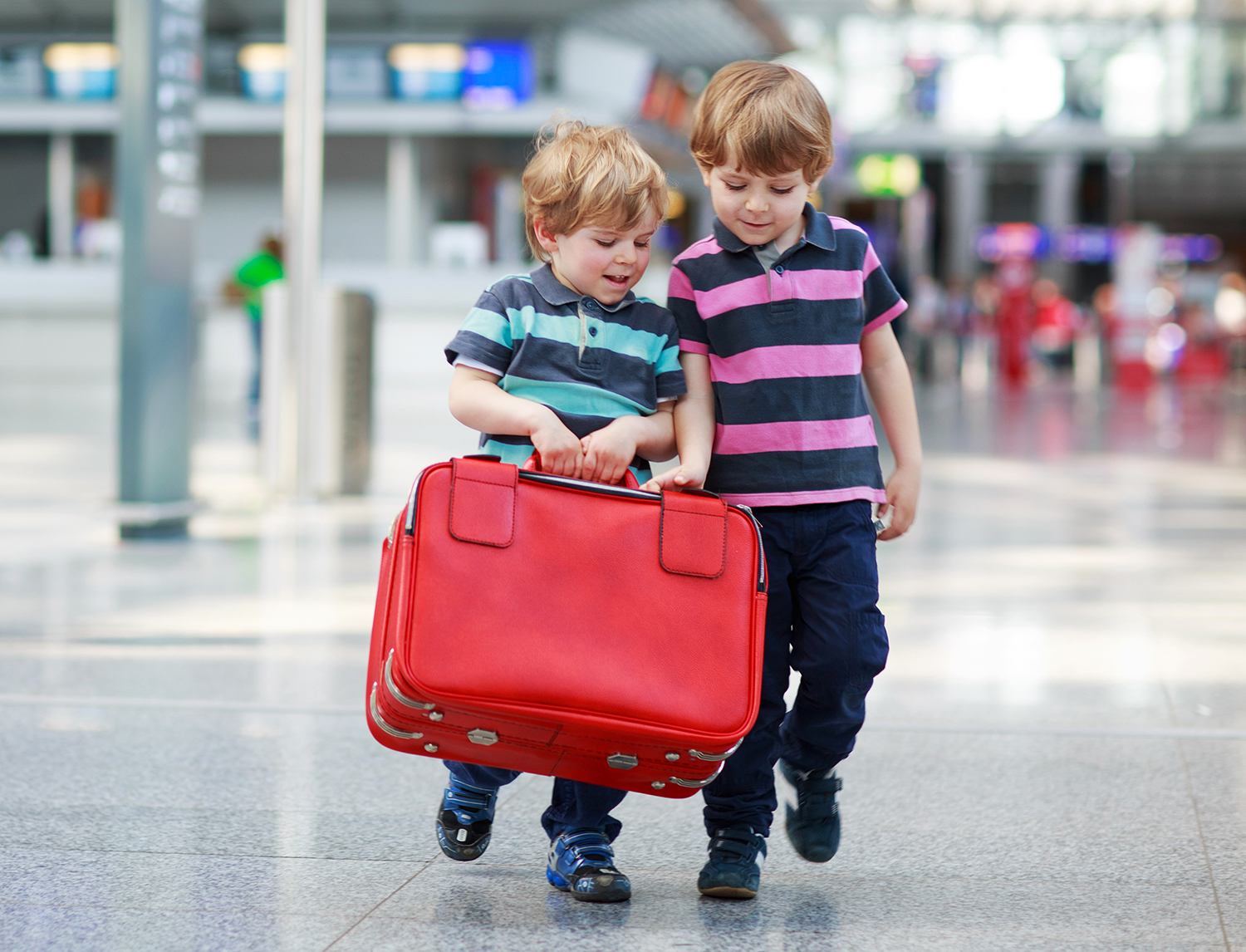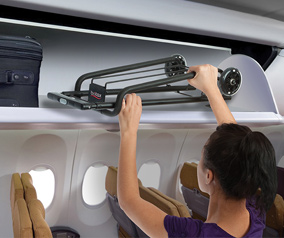Flying with Children
When flying with a baby or toddler, a bit of preparation can make all the difference! Avoid airport meltdowns with tips from our in-house safety expert, Sarah Tilton, on planning and preparing for your trip, navigating through the airport, transporting your car seat, and most importantly, traveling safely.

Planning Your Trip: How your child should be seated on the plane
Children up to 40 pounds
The safest way for children up to 40 pounds to travel on a plane is in a harnessed car seat or child safety restraint system. While the FAA does permit children under the age of 2 to sit on your lap during a flight, they strongly recommend that children be secured in a car seat that is installed on an aircraft seat to protect from injury during take-off, periods of in-flight turbulence, and landing.
Children over 40 pounds
For children over 40 pounds, sitting in their own seat and being secured with the aircraft lap belt is a safe and acceptable option. However, if you plan to bring along your child’s car seat so that you can use it when you reach your destination, you may want to consider securing your child in the seat on the aircraft rather than checking it as luggage. This will protect the car seat from damage that might occur while being handled by the baggage crew or during the flight.
Planning Your Trip: Purchasing Tickets
Choosing a flight
If the cost of purchasing a separate ticket for your child is a concern, you may want to consider choosing a flight during non-peak hours. Call the airline and ask if there are flights to your destination that tend to not be full. Ask if there are any discounts for child seating on those flights. If you can be flexible with your travel times, you can often get assistance from the airlines.
Before booking your tickets, you should also check with the airline for any guidelines or regulations they may have for traveling with young children, including minimum age, documentation requirements, and seating positions.
Seat assignments
When booking your tickets, make sure you get seat assignments so your family is sitting together. Sometimes when you order your tickets well in advance of the travel date, seat assignments are not yet available online, so you may need to call the airline to speak with an agent.
Seating positions
Be sure to book a window seat if your child will be secured in a car seat during the flight. Since car seats can be bulky, positioning them in a window seat will allow any other passengers seated in the row to be able to enter or exit the row freely. Car seats should also not be installed in any seating position in an exit row.

Planning Your Trip: Preparing for the flight
Your car seat
In order to secure your child in a car seat on an aircraft, the car seat must be FAA approved. Look for a label on the side of the seat that says “This child restraint system conforms to all applicable Federal Motor Vehicle Safety Standards” and “This restraint is certified for use in motor vehicles and aircraft.” All Britax harnessed car seats, including infant car seats, convertible car seats, and combination harness-2-booster seats, are certified for use on aircraft. Belt-positioning booster seats are NOT FAA approved and should not be used to secure your child on a plane. Belt-positioning booster seats require both a lap and shoulder belt to restrain your child and aircraft only have lap belts.
Your child
To help prepare your child for the journey and minimize headaches and meltdowns along the way, try these tips:
- When planning the outfit your child will wear on the day of the flight, choose clothes, shoes, and accessories that are free of rhinestones or any other metallic accessories that would set off the alarm during security.
- Review the information on the Transportation Security Administration’s (TSA) website regarding the security screening process for children.
- Talk to your child ahead of time to prepare them for what they may encounter during the security process to help minimize fears or anxiety they may feel at the airport. If your child will be traveling with a “lovey” – such as a teddy bear, baby doll, or another favorite toy –let them know that they will need to be separated from the toy for a few minutes while going through security.
- Come prepared with everything you think you’ll need to entertain your children, and then some! Items such as their favorite snacks, books, and toys will help them stay occupied and comfortable for the flight.
Your luggage
Before packing any carry-on bags, check the FAA and TSA websites for information on what you are allowed to bring on board with you. This is especially important if you’ll be traveling with breast milk, baby formula, or baby food.
During Your Trip: At the airport
Making your way through the airport with a child, luggage, and a car seat can be a challenge. Britax offers three solutions to make transporting your car seat more manageable:
- Car Seat Travel Cart: Convertible car seats and combination harness-2-booster seats quickly and easily attach to the Britax Car Seat Travel Cart using the seat’s lower LATCH connectors. You can even secure your child in the car seat and transport them through the airport with the cart. Once on the plane, the Car Seat Travel Cart folds compactly to fit in most airplane overhead compartments.


 Car Seat Travel Bag: If you plan to use a luggage cart at the airport to transport your bags, you may want to consider the Britax Car Seat Travel Bag, which provides more protection than the Travel Cart and contains the seat and all of its components neatly inside. The Travel Bag also has wheels on the bottom for rolling and shoulder straps for carrying on you back. The Car Seat Travel Bag accommodates all Britax harnessed car seats.
Car Seat Travel Bag: If you plan to use a luggage cart at the airport to transport your bags, you may want to consider the Britax Car Seat Travel Bag, which provides more protection than the Travel Cart and contains the seat and all of its components neatly inside. The Travel Bag also has wheels on the bottom for rolling and shoulder straps for carrying on you back. The Car Seat Travel Bag accommodates all Britax harnessed car seats.
- V-Shaped Tether: On Britax convertible and combination harness-2-booster seats, you can attach the V-Shaped Tether to a hook on the back of the seat to create shoulder straps for carrying the seat backpack-style.
During Your Trip: On the plane
Installing the car seat
The car seat should be installed in a window seat using the aircraft lap belt. Install the car seat in the direction you would install it in your vehicle – rear-facing for young children, and forward-facing for older children. On some aircraft, it may be difficult to install a car seat rear-facing due to space, so consider booking seats in a bulkhead row for extra room.
Ear pressure
During take-off and landing, the change in altitude may cause ear pressure discomfort for children. Having your child eat, drink, or use a pacifier during take-off and landing will help relieve pressure.
Mom’s Comfort
If you are flying while pregnant, consider wearing compression socks and performing leg stretches every hour to prevent uncomfortable swelling in the legs and ankles.